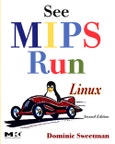See MIPS�Run, Second Edition, is not only a thorough update of the first edition, it is also a marriage of the best-known RISC architecture--MIPS--with the best-known open-source OS--Linux. The first part of the book begins with MIPS design principles and then describes the MIPS instruction set and programmers' resources. It uses the MIPS32 standard as a baseline (the 1st edition used the R3000) from which to compare all other versions of the architecture and assumes that MIPS64 is the main option. The second part is a significant change from the first edition. It provides concrete examples of operating system low level code, by using Linux as the example operating system. It describes how Linux is built on the foundations the MIPS hardware provides and summarizes the Linux application environment, describing the libraries, kernel device-drivers and CPU-specific code. It then digs deep into application code and library support, protection and memory management, interrupts in the Linux kernel and multiprocessor Linux.
Sweetman has revised his best-selling MIPS bible for MIPS programmers, embedded systems designers, developers and programmers, who need an in-depth understanding of the MIPS architecture and specific guidance for writing software for MIPS-based systems, which are increasingly Linux-based.
Please Note: This is an On Demand product, delivery may take up to 11 working days after payment has been received.
Table of Contents
1. RISCs and MIPS 2. MIPS Architecture 3. Coprocessor 0: MIPS Processor Control 4. How Caches work on MIPS 5. Exceptions, Interrupts, and Initialization 6. Low-level Memory Management and the TLB 7. Floating-Point Support 8. Complete Guide to the MIPS Instruction Set 9. Reading MIPS Assembler Language 10. Porting Software to MIPS 11. MIPS Software Standards ("ABI�s) 12. Debugging MIPS debug and profiling features 13. GNU/Linux from Eight Miles High 14. How hardware and software work together 15. MIPS-specific issues in the Linux kernel 16. Linux Application Code, PIC and Libraries
Appendix A. MIPS Multithreading B. Other Optional extensions to the MIPS instruction set MIPS Glossary
Authors
Dominic Sweetman MIPS Technologies.Dominic Sweetman is a member of the last generation of programmers who could reasonably hope to understand computer systems from bottom to top. His rich career began with low-level coding, progressing from OS development to LANs to distributed systems. Dominic is an experienced designer and developer of hardware systems, CPUs, networks, and operating systems. He was a founder member of Whitechapel Workstations, and in 1988 founded Algorithmics, a MIPS consulting firm of which he is the director. Dominic lives with his partner, two grown-up children and three cats in north London.








